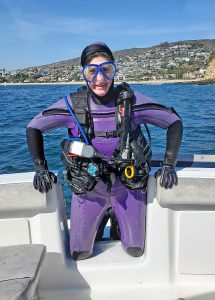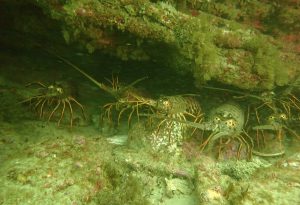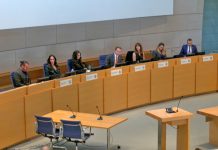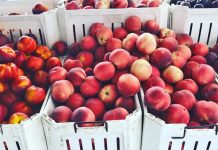By Rita Robinson, Special to the NB Indy
It was just after sunrise; a bright, chilly morning, light breeze and calm seas as Capt. Nancy Caruso and her crew of two divers headed out in their small motor craft.
Caruso, instrumental in rebuilding the kelp forests and replanting green abalone, was on a mission: to make 12 dives in two days to assess the health of underwater marine plants and animals after the Oct. 2 Orange County oil spill.
“I was really happy to pull out of Newport Harbor and look down the coast,” said Caruso, a marine biologist and founder of Get Inspired, an ocean monitoring and restoration nonprofit. It was her first day of the dives. “It was glassy, no swell.”
The second day was last Saturday, this time heading out of Dana Point Harbor, diving at six reefs with the last dive at Shaw’s Cove in Laguna Beach.
Due to an incoming La Nina weather pattern, ocean conditions were unpredictable. The typically clear, warm waters straggling from summer into the fall didn’t happen.
“This whole year has been really horrible with wind and swell and trying to get out to dive,” she said. Getting into the water at shallow reefs proved particularly difficult. “The water just tosses you around with so much surge.”

What her divers would find was also unpredictable. With decades of diving experience each, many of those in scientific endeavors, it would be the first half of 12 investigative dives for retired aeronautics engineer and dive-instructor Wayne Phillips and marine biologist and dive master Julianne Steers, founder of the Beach Ecology Coalition. Both volunteered for the mission.
First day, first stop, Little Corona.
The boat pulled into the bay. Suited up, Phillips and Steers plunged into the 59-degree water for a 15-minute survey while Caruso held the craft steady. With getting in and out of the boat, there was no time for putting down and pulling up anchor and finish by 4 p.m.
Four more stops in Crystal Cove and the last in Emerald Bay, the northern border of Laguna Beach’s Marine Protected Area, a no-take zone where fishing is prohibited.
The instigating spill last month, first calculated at 141,000 gallons of crude oil, was downsized to 24,000 gallons after investigation. Ten oiled sea birds, a relatively small number, were rescued, rehabilitated and released by Oiled Wildlife Care Network. On the surface, oceans, beaches, bays and marshes escaped extensive damage. Now it was time to go deeper.
The crew’s apprehension ebbed into relief. “It was certainly a delight,” said Steers after the dives. Rock scallops closed their bivalve shell when crossed by the divers’ shadows. “They were doing what they’re supposed to do,” she said. “They filter water throughout the day so they would be affected first.”
“When they touched a lobster, it darted away,” reported Caruso. “The snail closed up its operculum when the divers touched the snail.” The second day of dives proved the same results, she added. Every animal, from a giant horned shark to sea hares, abalone and the colorful miniscule nudibranchs, responded quickly and behaved naturally. “There was no lethargy,” Phillips said happily.

The surveyors even checked the condition of invasive species, specifically the invasive seaweed sargassum. “It was doing well, too, unfortunately,” Caruso chided.
At the request of NOAA’s Natural Resource Damage Assessment team, Caruso was asked to collect dead marine animals and tar balls. The animals’ tissue would be used to determine if the pH of the oil from the spill matches the pH of the oil that killed the animals. “Luckily, we didn’t find anything to collect,” she said.
The final set of Caruso’s six investigative dives took place Saturday, Oct. 30, starting at Crescent Bay in Laguna Beach.
But an even bigger take-away for the team that day was the difference seen between the state Marine Protected Area at Emerald Bay in Laguna Beach compared to the five diving sites surveyed in Newport Beach, which allows fishing and lobster trapping.
Sea life in the MPA kelp forests was teeming. “It was noticeable how abundant the marine life was there compared to the other sites,” said Phillips. “I thought, ‘These lobsters are huge.’ You could really see the difference.”
Caruso has her reasons. “There’s only a small amount of sargassum in the reserve compared to unprotected areas because there’s more kelp,” she said. “The kelp out-competes it. There is a difference and there should be a huge difference because nobody can fish in a reserve.”
When there’s an intact ecosystem and all players are present, particularly the keystone giant kelp forests, the native marine animals exist in natural prey-predator balance and the ecosystem is more resilient to stave off invasive species, she said.
“It’s still there [sargassum] but it can’t take hold because the kelp has dominance over the reefs,” she said. “Kelp is better at living in that ecosystem so it will take over when it has the chance. It’s pretty awesome.”
So all seems well for the short term. The final analysis is still to come on long-term microbial effects involving zooplankton and phytoplankton. But a team of researchers at UCI are diligently filtering water samples daily.
Oil affects bacteria, the mini-microorganisms of phytoplankton, differently. Some bacteria actually break down certain parts of oil, such as hydrocarbons, and use it as energy, explained Melissa Brock, Ph.D. student researcher with UCI’s Adam Martiny lab for microbiology, environmental genomics and oceanography. “We’re expecting that they’re really happy right now,” she said
But organisms that find oil toxic probably won’t do as well, she said. “So we expect to see an increase in those bacteria that can use parts of the oil and a decrease in the bacteria that find it toxic. One of the big questions we’re interested in is how long does it take for those effects to go away, how long does it take the bacterial community to return to pre-spill conditions?” The lab references 10 years of data from surveying ocean water once a week at Newport Beach pier. They are now collecting samples three times a week and expect to release results within two months.
“Everything could have been a disaster, a cascade effect,” said Caruso. “We don’t know what happened to the larvae, all the fish eggs, all the planktonic organisms that are important to our food chain and to the growth of those animals living there right now like the planktonic kelp spores that are being released and landing on the rocks. We may see effects of this oil spill in a year, three years, five years because we don’t know how it affected the microscopic world.”
For now, the team happily reports positive results.




